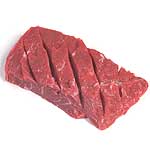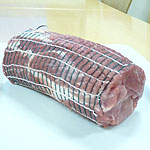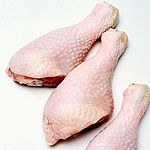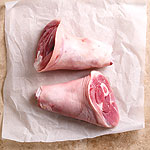Meat & poultry – alternative cuts
When times are tough, it makes sense to look at some of the cheaper cuts of meat and poultry. As ever, the trick is to buy a good-quality product, as Tom Vaughan reports.
How many kitchens these days buy their animal carcasses whole? Very few, is the answer. As a result, more and more chefs are losing the innate understanding of butchery and that hearty list of alternative cuts. As André Garrett, head chef at Galvin at Windows in London, says: "These days, chefs and restaurateurs are running out of chefs skilled in butchery, so we need to rely on butchers to help us explore different cuts of meat."
To show what can be done, we've talked to butchers, chosen five alternative cuts of meat and explored the possibilities.
ONGLET
Substitute for: prime steak cuts - for example, fillet
How to cook: marinate then grill, serve medium rare, rest for two to three minutes and cut into slices
Price: can be up to half the price of fillet steak
Called hanger steak in the US because it hangs from the diaphragm - what we call the skirt in Britain - onglet is a classic French brasserie steak that we have often ended up mincing or stewing in this country.
If you talk to your butcher, it's perfectly possible to turn what we would traditionally see as a stewing cut into a prime one. And they should know; traditionally the cut was referred to as butcher's steak in Britain because, knowing it wouldn't sell for much and as an onglet cut it would take more skill to cook, they would reserve it for their families.
Jason Atherton, executive chef at Maze in London, is a keen admirer of the cut. "I'm a big fan of beef, but when you ask people what they like from the animal it's always the same - it's always fillet," he says. "But fillet has no real flavour, it's hard for it to get much flavour from the position it is in the animal. Onglet, on the other hand, has lots and lots of flavour.
"However, it needs skill to cook. You have to age it for 28 days, you have to marinate it and then grill it, but not for too long or it becomes tough. It is still naturally chewier than fillet but it has this great flavour. It's a cut of meat that challenges me as a chef."
BLADE OF BEEF
Substitute for: prime summery steaks during colder months
How to cook: braise for six hours, cut into steaks and brown in a frying pan for service
Price: can be up to half the price of fillet steak. A whole blade will produce about seven or eight good-sized steaks at about £2 per portion
Taken from the shoulder of the animal, the blade is a particularly hard-working ligament on the animal, hence it needs to be approached correctly in the kitchen. It also needs to be sourced well, insists Simon Smith, sales manager at Aubrey Allen butchers.
"From the wrong cow, it's a disaster," he says. "If it is from a good suckler herd that has been allowed to grow naturally, the tendon that runs through it turns to jelly. If it is off poor-quality beef, it doesn't. The fat content has to be correct from the ageing process."
Clive Dixon, head chef at the Hinds Head in Bray, has used the cut for years. "You don't often see whole blades - they're often cut into flat iron steaks - but once a butcher puts his knife through it the whole structure of the cut is changed. But bought whole and braised down, that tendon that runs through the meat gives it the most sumptuous moistness."
The cut can be cooked sous vide for 14 hours or braised traditionally for five hours, then cut into steaks and pan-fried.
NECK FILLET OF LAMB
Substitute for: lamb cannon
Price: can cost a third of the price of lamb cannon
Cut from the scrag end, the lamb neck fillet can be tough because of the workout it gets from grazing sheep but it also contains a lot of fat which, cooked down slowly, gives the cut a lovely sweetness, says Matt Tough, sales and marketing director at food purchasing company PSL and an ex-butcher.
Colin Buchan, head chef at London's York & Albany restaurant, is a particular fan of the cut and marinates it for 24 hours, then cooks it at 110ºC for three hours.
"The flavour and texture of it is fantastic, as is the price," he says. "You can obviously get shoulder and leg but neck fillet is cost-effective, it's manageable in the kitchen - you can get a lot done with it for little work - you get nice tidy portions from it and it looks good on the plate."
RIB EYE OF PORK
Substitute for: pork fillet
How to cook: sous vide or braise for six to 10 hours then finish on a plancha or pan-fry during service
Price: can cost two-thirds the price of pork fillet. A whole rib-eye will yield about eight to 10 portions at less than £2 each
In exactly the same position on the carcass as the rib-eye of beef, the rib-eye of pork is as good a cut of pork as any and a good winter alternative to pork fillet or the ubiquitous pork belly. Again, says Smith, it needs to be off the right pig, one that has been slow grown to give the right muscle-fat content so it will cook down nicely.
André Garrett has the cut on his menu. "It's quite a muscular piece of meat so it needs long, slow cooking," he says. "We put it in a water bath as a whole piece for eight to 10 hours at 62ºC. Afterwards, all the protein is cooked through but it is pink. Then we finish it off on a plancha during service and plate it up with some winter vegetables."
And how does it taste? "It's got this seam running through it that holds it all together. There's no toughness, it's just lovely and tender. You might think you were eating pork fillet. It's a case of taking something I wouldn't have bought before and turning it into a modern dish."
CHICKEN LEG
Substitute for: chicken breast
Price: a chicken bought whole and broken down means the legs will cost a nominal price
Anyone can make use of a chicken breast, hence its enduring popularity. But once you've removed the breast from a carcass - if you're buying it in whole, which you'd be a fool not to do, says Tough - what can you do with the leg that's vaguely original?
Corin Earland, head chef at the Almanack Pub in Kenilworth, brainstormed a clever answer. "We wanted to go free range and it's a much better price to get the whole bird," he explains.
"The price for a breast was £3.30 and the price for a whole bird was £6.50. We had no trouble shifting the breasts on the menu but the legs weren't so popular. I went down to Aubrey Allen for a day and we brainstormed different ideas. What we ended up on was mincing the chicken and forming it into burgers and grill sticks with a good herb mix bringing it to life."
The grill sticks now form the backbone of the pub's most popular dish; its chicken Caesar salad. The minced chicken is easy to portion up into 70g sticks and can also be used for burgers or for a homemade chicken kiev.
"What's more," says Earland, "we have things like the chicken livers to make pâté from and the bones to make stock from."
SOME MORE SUGGESTIONS
PORK
Pork shoulder Pork hocks
Cuts of pork taken from the forequarter, such as shoulder, collar and belly, are often under-rated but offer value-for-money alternatives to loin and legs.
Ham hocks are easy to prepare and deliver an exceptional cost per portion ratio. Hock has grown in popularity thanks to dishes such as ham hock terrine.
Pork head meat, cheeks, tail, knuckle and offal are starting to make a comeback and can be served as pressed pig's head, faggots, braised pork knuckle, stuffed trotter and braised pork cheeks.
Source: BPEX
BEEF
Tender top steak is very popular in Europe and often used as an alternative to rump steak. It's very tender with a short grain and has excellent flavour. Taken from the single centre muscle, this steak has consistent eating quality.
Pavé (underblade) is tender and succulent with a unique flavour. If handled well the tenderness could be mistaken for fillet and is ideal as an alternative to the popular cut but with more intense flavour. It comes from the forequarter and, if cut correctly, can look and eat like a fillet steak. Once fully trimmed it produces a very tender, juicy pavé with a short and fine grain meat.
Source: EBLEX
JASON ATHERTON'S ONGLET STEAK WITH PUMPKIN JAM, RATTE POTATOES AND BEEF SAUCE
INGREDIENTS
(Serves four)
- 4 x 250g onglet steaks, trimmed, with trimmings reserved for the sauce
For the pumpkin jam
- 1.25kg peeled pumpkin
- 1/2 cinnamon stick
- Small piece nutmeg, smashed
- 4 cloves
- 1/4tsp ground mace
- 375g caster sugar
For the beef sauce
- 25g butter
- 90g beef trimmings (from the steaks)
- 3 banana shallots, peeled, finely chopped
- 1/4 garlic bulb
- 2 sprigs fresh thyme
- 1 fresh bay leaf
- 1/2tsp white peppercorns
- Pinch of salt
- 25ml brandy
- 150ml sherry vinegar
- 750ml red wine
- 500ml chicken stock
- 500ml veal or beef stock
- 3tbs fine capers, drained and rinsed, finely chopped
- 3tbs chopped fresh flat leaf parsley
For the potatoes:
- 1kg beef fat, roughly chopped
- 1 garlic bulb
- 6 sprigs fresh thyme
- 4 fresh bay leaves
- 300g whole Ratte potatoes, skin left on and cleaned
- Salt and pepper
- 110g butter
- 250g fresh girolle stems
- 250g fresh trompettes
- 500g kale
METHOD
To make the pumpkin jam, steam the pumpkin until tender and blitz. Grind the spices and blitz to a powder, place a pan over a low heat and add the pumpkin purée, sugar and spices. Reduce slowly for 11/2 hours, stirring constantly, until it has the consistency of jam. Season and chill. Do not pass - keep in the raw spices.
For the beef sauce, heat a pan over a medium heat, add the butter then brown the beef trimmings. Add two-thirds of the chopped shallots and all of the garlic, the thyme, bay leaf, white peppercorns and a pinch of salt and cook for 2-3 minutes until the shallots are caramelised.
Add the brandy and light with a match, then allow to burn out. Reduce the liquid until almost gone, add the sherry vinegar, reduce by two-thirds, then add red wine, reduce by two-thirds again, then add the stock and leave to simmer for 20 minutes. Pass into a clean saucepan and return to the heat to reduce to a sauce consistency. Season to taste then stir in the capers, parsley and remaining shallots.
For the potatoes, add the beef fat, garlic, thyme and bay leaves to a pan over a medium heat until melted, then add the potatoes, cover in the fat and reduce the heat to 100°C and cook for 20-25 minutes until tender. Remove with a slotted spoon and allow to drain on kitchen paper.
For the mushrooms, add 55g of butter to a pan on a medium heat until foaming, add the mushrooms and fry for 2-3 minutes. Cook the curly kale leaves in a pan of salted, boiling water for 1-2 minutes, or until just tender, then drain. Heat a frying pan until hot, then add the remaining butter. When the butter is foaming, add the boiled kale and fry for a further 1-2 minutes until wilted then season.
For the onglet steaks, rub the steaks all over with a little olive oil and season. Heat a griddle pan over a high heat. When the pan is hot, place the steaks on the griddle and cook for 2-3 minutes on each side. Remove from the pan and set aside to rest for 2-3 minutes.
To serve, carve each steak into two pieces and place them into the centre of each of four serving plates. Place a spoonful of the chilled pumpkin jam on either side of the steak. Dot some of the wilted kale on top of each steak, then spoon over the mushrooms. Place three or four potatoes alongside. Drizzle over the beef sauce.
CONTACTS
Aubrey Allen
024 7642 2222
BPEX
024 7647 8809

















